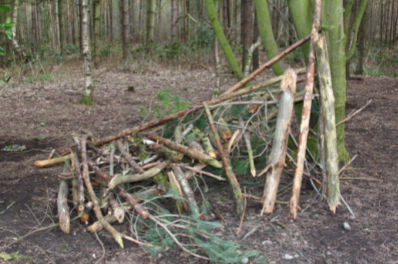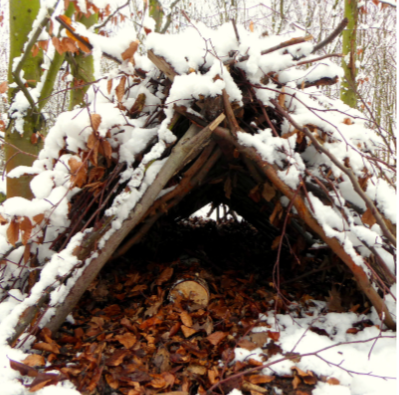Common Mistakes to Avoid When Choosing and Building a Wilderness Shelter, Insights from Mountain Men
- Nature Ready Outdoors
- May 22, 2024
- 5 min read
Updated: Aug 5, 2024
When it comes to surviving in the wilderness, choosing and building the right shelter can make all the difference. While modern survivalists have the advantage of advanced tools and materials, we can learn a lot from the mountain men and frontiersmen who lived off the land centuries ago. These hardy individuals faced harsh conditions with minimal resources, and their experiences offer valuable lessons for today's beginners. Here, we’ll explore common mistakes to avoid when choosing and building a wilderness shelter, with insights drawn from the lives of historical mountain men and frontiersmen.
Common Mistakes to Avoid
Mistake 1: Ignoring the Lay of the Land
One of the most critical mistakes beginners make is selecting a shelter location without considering the terrain. Mountain men like Daniel Boone and Jim Bridger knew that the lay of the land could spell the difference between comfort and disaster.
Lesson from Mountain Men
Mountain men often chose elevated ground to avoid flooding. In his memoirs, Jim Bridger emphasized the importance of avoiding valleys and low-lying areas prone to water accumulation: “A night of rain can turn a gentle brook into a torrent” (Bridger, 1840).
Avoid This Mistake By:
Choosing elevated, flat ground.
Avoiding valleys, streambeds, and areas with visible water flow.
Looking for natural windbreaks to shield from the elements.
Mistake 2: Overlooking Natural Resources
Beginners often overlook the availability of natural resources when choosing a shelter site. Without adequate materials for building and maintaining a shelter, even the best location can become a liability.
Lesson from Mountain Men
Mountain men relied heavily on their surroundings. They used what nature provided, from wood for structures to leaves for insulation. Daniel Boone was known for his ability to identify and utilize natural resources efficiently.
Avoid This Mistake By:
Scouting the area for ample building materials like branches, leaves, and rocks.
Ensuring the availability of water sources nearby.
Gathering resources before nightfall to avoid working in the dark.

Mistake 3: Poor Shelter Construction
Constructing a shelter that can withstand the elements is crucial. Beginners often build shelters that are either too flimsy or improperly insulated.
Lesson from Mountain Men
Frontiersmen like Kit Carson stressed the importance of a sturdy, weather-resistant shelter. Carson noted in his journals that a well-constructed lean-to or debris hut could make the difference between a comfortable night and hypothermia (Carson, 1850).
Avoid This Mistake By:
Building a solid frame using sturdy branches.
Insulating the shelter with leaves, moss, or other natural materials.
Ensuring the shelter is small enough to retain body heat but large enough to be comfortable.
Mistake 4: Neglecting Shelter Orientation
The direction your shelter faces can significantly impact your comfort and safety. Beginners often neglect to consider factors like wind direction and sun exposure.
Lesson from Mountain Men
Mountain men like John Colter understood the importance of shelter orientation. Colter would often position his shelters to maximize warmth and minimize exposure to prevailing winds (Colter, 1810).
Avoid This Mistake By:
Orienting the shelter entrance away from prevailing winds.
Positioning the shelter to receive morning sunlight for warmth.
Avoiding direct exposure to midday sun, which can lead to overheating.

Mistake 5: Inadequate Ventilation
A common mistake is creating a shelter that is too enclosed, leading to poor ventilation. This can result in moisture buildup and even carbon monoxide poisoning if a fire is used inside.
Lesson from Mountain Men
Frontiersmen like Hugh Glass were well aware of the dangers of poor ventilation. Glass often incorporated ventilation holes into his shelters to ensure a constant airflow (Glass, 1820).
Avoid This Mistake By:
Including small openings for ventilation, especially if using a fire.
Ensuring that smoke can escape if you have an indoor fire.
Balancing insulation with adequate airflow to prevent condensation.
Mistake 6: Ignoring Weather Patterns
Failing to consider the weather can lead to severe discomfort or even danger. Beginners often don't account for potential changes in weather when building their shelters.
Lesson from Mountain Men
Mountain men like Jedediah Smith were acutely aware of weather patterns. Smith often checked the sky and wind for signs of changing weather and adjusted his shelter plans accordingly (Smith, 1830).
Avoid This Mistake By:
Observing the weather and making shelter decisions based on potential changes.
Building a shelter that can withstand rain, wind, and temperature fluctuations.
Keeping an eye on the sky for signs of impending storms.
Mistake 7: Lack of Preparation and Planning
Rushing into shelter building without a plan can lead to inadequate or unsafe structures. Beginners often underestimate the time and effort required.
Lesson from Mountain Men
Preparation was key for mountain men like Simon Kenton. Kenton meticulously planned his shelters, ensuring he had enough daylight and resources to complete them (Kenton, 1780).
Avoid This Mistake By:
Planning your shelter before starting construction.
Gathering all necessary materials before nightfall.
Allowing ample time to build a secure and comfortable shelter.

Mistake 8: Underestimating Wildlife
Choosing a shelter site without considering the presence of wildlife can be dangerous. Beginners often overlook signs of animals and build in areas frequented by predators or pests.
Lesson from Mountain Men
Mountain men like James Beckwourth knew the importance of avoiding wildlife trails and habitats. Beckwourth advised setting up camp away from animal paths and food sources to avoid unwanted encounters (Beckwourth, 1856).
Avoid This Mistake By:
Looking for signs of wildlife, such as tracks, droppings, or nests.
Avoiding areas with abundant food sources that attract animals.
Choosing locations that offer natural barriers to wildlife.
Conclusion
By learning from the experiences of mountain men and frontiersmen, modern wilderness enthusiasts can avoid common mistakes when choosing and building shelters. Paying attention to the lay of the land, utilizing natural resources, constructing sturdy and well-oriented shelters, ensuring ventilation, and planning for weather and wildlife can significantly enhance your survival experience. Remember, the wisdom of the past can guide us to safer and more effective practices in the wild.
Do's and Don'ts Checklist for Wilderness Shelters
Do's:
Choose elevated ground: Select sites on higher ground to avoid flooding.
Scout for resources: Ensure the availability of natural building materials and water sources.
Build a sturdy frame: Use strong branches and secure them firmly.
Insulate well: Use leaves, moss, and other natural materials for insulation.
Orient for safety: Position the entrance away from prevailing winds and towards morning sun.
Ensure ventilation: Include openings for airflow, especially if using fire inside.
Don'ts:
Don’t choose low-lying areas: Avoid valleys and streambeds prone to flooding.
Don’t overlook resources: Don’t settle in an area without adequate materials.
Don’t build flimsy shelters: Avoid weak structures that can collapse or fail in bad weather.
Don’t neglect orientation: Don’t ignore wind direction and sun exposure.
Don’t forget ventilation: Avoid sealing the shelter too tightly, which can cause moisture buildup and health hazards.
References
Bridger, Jim. Memoirs of a Mountain Man. 1840.
Carson, Kit. Journal of Kit Carson. 1850.
Colter, John. Adventures of John Colter. 1810.
Glass, Hugh. Hugh Glass: Mountain Man. 1820.
Kenton, Simon. Life and Adventures of Simon Kenton. 1780.
Smith, Jedediah. The Travels of Jedediah Smith. 1830.
Beckwourth, James. The Life and Adventures of James P. Beckwourth. 1856.


Comments